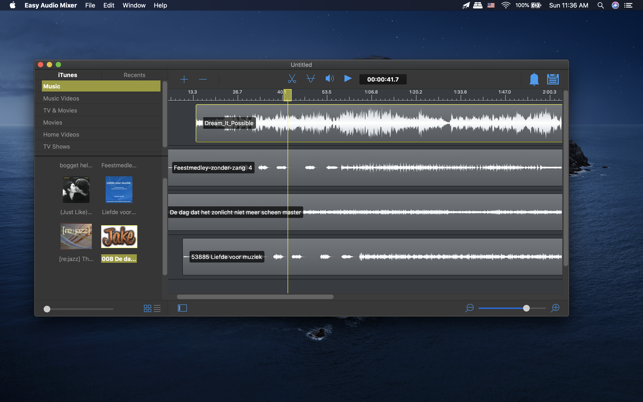Mac Apps for DJ. The DJ Software category contains programs designed to help you mix, edit, and add audio effects to your audio and video tracks.
Audio MIDI Setup User Guide
Use Audio MIDI Setup to set up audio input and output devices, such as microphones and multichannel audio interfaces. You can also use it to route audio from iOS and iPadOS devices directly into your Mac.
Available settings in Audio MIDI Setup depend on the audio device you’re using. For example, you can adjust the volume for each channel your audio output device has available.
Connect your audio devices to your Mac and, if necessary, install any software included with the devices.
In the Audio MIDI Setup app on your Mac, in the sidebar of the Audio Devices window, select a device.
Note: For iOS and iPadOS devices, first click Enable, then select the device. You may be asked to unlock your device with a passcode or to trust the device.
Control-click the device, or click the Configure Selected Device pop-up menu at the bottom-left of the sidebar, then choose how the device is going to be used:
For sound input: Choose Use This Device for Sound Input.
For sound output: Choose Use This Device for Sound Output.
For playing system sounds: Choose Play Alerts and Sound Effects Through This Device.
On the right side of the Audio Devices window, choose the options available for the device you selected:
In most cases, “Clock source” is set to the default.
Click the Format pop-up menu, then set the sample rate and bit depth. Make sure they match the appropriate settings for your audio device.
If your Mac supports the hardware sample rate converter, the Hardware Rate Converter pop-up menu is available in the Input pane. When you choose Automatic from the pop-up menu, the hardware sample rate converter is turned on if the audio samples coming in are PCM and formatted according to the international standard IEC 60958-3. The hardware sample rate converter is turned off if the input stream is encoded. You can also choose Enable or Disable from the menu, to keep the hardware sample rate converter turned on or off.
If software volume control is available for your device, the Volume sliders appear blue to indicate that they’re active. Drag the sliders to set the volume for each channel.
To set up a surround (multichannel) speaker configuration, click Configure Speakers, then set up the configuration.

If the mixer has audio line-out, and your MacBookPro has an audio line-in you can record the output of the mixer in Garageband. Your mixer has two outputs - 1) 2x RCA and 2) 2x 1/4' TRS. You will need a cable with one pair of connectors matching the mixer output you want to use, and on the other end a single 3/8' (aka 2.5mm) male stereo plug to connect to your MacBookPro.
In GarageBand you will record from the audio input. There is no 'connection' between the mixer and GarageBand per se.
Audio Mixer Software
Note: You didn't say what model MacBookPro you have. In the current lineup, only the 15' MacBookPro still has audio line-in. Check yours to make sure it has an audio-in port.

Mac Sound Mixer
Feb 20, 2013 8:37 PM